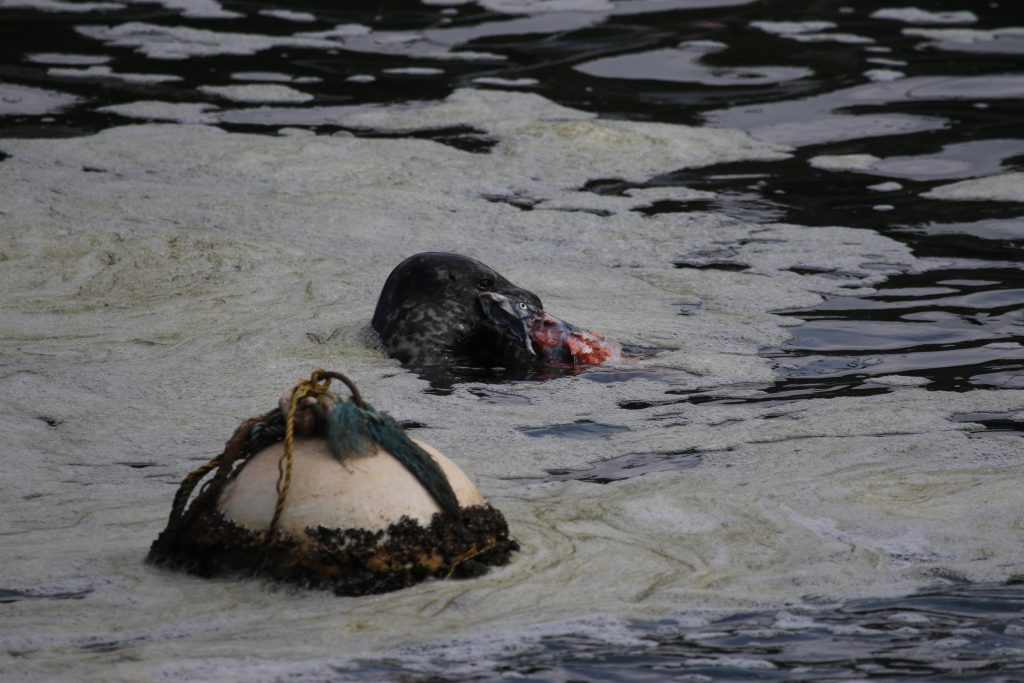
‘TAST’ Test To Give Harbor Seals Unexpected Earfuls At Ballard Locks In New Effort To Reduce Salmon Predation
A new acoustic device designed to scare pinnipeds away from salmon chokepoints is being tested at the Ballard Locks, with initial observations suggesting it has moved harbor seals away from the entrance to Lake Washington and the Chinook now migrating through there.

Even as the question of how effective it will be on these smart marine mammals down the road remains open, it represents a new tack in the effort to save salmon runs and hopefully is a far more useful option than other nonlethal methods have proven to be.

“During the first week of observing with the TAST on, it feels like the seals have shifted away from the fish ladder compared to observation days when the TAST was off. We are keen to see if this observation is also reflected in our data when it comes time for analysis,” said Laura Bogaard of Seattle-based Oceans Initiative in a joint press release.

TAST stands for Targeted Acoustic Startle Technology, developed at a Scottish university and which “uses sound to startle animals and induce a flight response, causing the animal to leave the area, with the intention of training the animals to keep away altogether,” according to a press release out today.
Testing began in mid-August and is expected to last through fall’s coho run, with analysis this winter.

Among others, TAST is being touted by Long Live The Kings, which has worked for years to understand harbor seal predation and other issues affecting steelhead and salmon in Puget Sound and Hood Canal and what to do about them. LLTK created Survive the Sound, a virtual game that tracks real-life smolts as they migrate out of the Nisqually, Skokomish and Duwamish Rivers towards the Pacific while facing a host of problems, from pollution to predators.
The organization’s Lucas Hall says they are also wondering how effective TAST will be at keeping seals away over the long haul but hopes that “the technology and a strategic deployment approach will avoid habitation.”

“I will say that a couple seals have managed to get themselves in the ladder and underwater sound can’t do much for that. We’re hoping that once they leave the ladder the device will discourage them from reentering,” Hall said.
The device is being marketed by Scotland’s Genuswave.
“Studies on captive animals have demonstrated that the likelihood of a flight response and the strength of the avoidance behavior increased with each successive exposure,” the company’s website states.
That’s different than with more conventional deterrent devices that, according to Genuswave produce something akin to the “Dinner Bell Effect,” that is, rather than keeping seals away it ends up drawing them to the food source.


Essentially, TAST “produces short sounds that are unexpected and startling, but does not lead to hearing damage, as is often the case for other acoustic methods,” according to Oceans Initiative and LLTK, and it’s outside the range of whales.

Seals and sea lions are notorious for setting up shop at human-made chokepoints, exacerbating the problem of recovering salmon and steelhead runs suffering longterm declines largely caused by massive, all-encompassing habitat disruptions.
The problem has drawn new focus with the plight of Puget Sound’s southern resident killer whales being outcompeted for Chinook and other stocks by fellow marine mammals.
At the Ballard Locks, Hershel et al ate all (or at least most) of Lake Washington’s steelhead back in the 1980s despite the use of many different nonlethal tactics, none of which proved useful.
At Willamette Falls, before sea lion lethal removals were allowed and began, there was a nearly 90 percent chance that at least one of the Oregon watershed’s wild winter steelhead would go extinct if nothing were done, ODFW estimated.
“By removing those animals, we allowed over 1,300 extra winter steelhead to reach the spawning grounds this year,” said the agency’s Dr. Shaun Clement earlier this summer.
Sea lion removals at Bonneville Dam saved at least 30,000 to 35,000 Columbia spring Chinook, WDFW estimates.
However, managers do not yet have the legal ability to kill harbor seals, which means for now nonlethal is how they have to proceed.

Partners in the TAST test include the Army Corps of Engineers, which operates the locks, University of St Andrews, Puget Sound Partnership, Washington Department of Fish and Wildlife, Muckleshoot Indian Tribe, and others.

“We are always looking for new innovations to help the environment,” said Corps spokesperson Dallas Edwards in a press release. “We are excited to see the results of this study.”

If TAST is shown to work, it could be used at other pinchpoints that adult and juvenile salmonids must pass through on their way in and out of Puget Sound.
